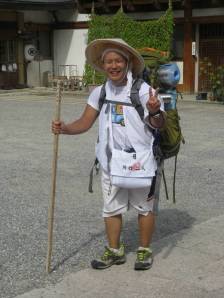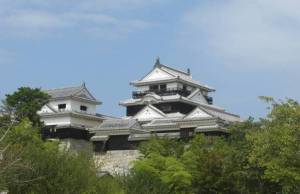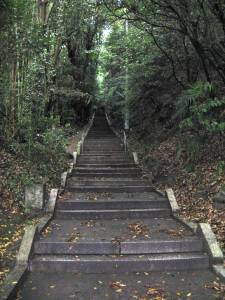For a holiday with a difference, Tony Gibb made a traditional Japanese pilgrimage, the O-Shikoku, by bike.

It seemed like a good idea at the time and, surprisingly, it turned out to be a very good idea. I would hire a bike in Onomichi and cycle the 70 or so kilometres along the Shimanami Kaido to Imabari on Shikoku, across seven of the biggest and most beautiful suspension bridges in the world. In three days I had a great time, the cycling was not challenging, I stayed in wonderful ryokans and the scenery across the Inland Sea was fabulous. What to do for an encore?
I’m a terrible tourist, a “Been there, seen that, what’s next?” sort of traveller. I need to slow down and what better way than to cut back to cycle speed. My great experience on the Shimanami Kaido led me to look at the possibility of riding a bike around Japanese Buddhist pilgrimage routes as a way of re-capturing the Shimanami experience. The greatest of these is the 88 temple O-Shikoku pilgrimage on the island of Shikoku. This is a walking circular pilgrimage of about 1400km but many Japanese do the Shikoku by bus and by car. The pilgrimage route was established in about 800AD by the monk Kobo Daishi. Kobo Daishi had an ascetic streak so that many of the temples are at the top of steep paths or many stairs.

By following the pilgrim route I would have a structured itinerary, access to plenty of accommodation set up for other pilgrims and a paced opportunity to see a remnant of ancient Japan at ground level. Shikoku has spectacular scenery and is one of the most unspoilt and beautiful areas of Japan. Half the island faces the Seto Inland Sea. There were few Western tourists on the island and plenty of good public transport so that, if and when I grew impatient, I could skip ahead on buses and trains and the occasional taxi. The slow pace of travel gave me access to events happening beside and off the road, such as school sports days.
To keep open my option to travel on public transport, I took a folding bike with me to Japan. This folded up into a bag and was allowed on buses and trains when in the bag. The bike was my best friend when I and my pannier bags rode on it. When it was in the bag and I had to carry it plus the bags it was much less of a friend.

My first task on Shikoku was to buy a nokyocho and a pilgrim’s vest. The nokyocho is a book in which to collect stamps from each temple along my route. This gave me an opportunity to interact with the priest at each temple and made a terrific souvenir of the trip. Each page has a beautiful inscription written by the priest and three bright red stamps. The white pilgrim’s vest had an inscription on the back that identified me as a pilgrim and, I’m sure, made cars and trucks give me an extra wide berth on the road. It also attracted an occasional settai or offering to a pilgrim. By giving settai, people share in the merit of the pilgrimage and confer blessing and goodwill on the pilgrim. I received drinks, sweets and hotel discounts as settai. It is extremely rude to refuse such gifts.
The pilgrimage crosses four prefectures of Japan and each has its own meaning as part of a spiritual journey. Tokushima is the Place of Spiritual Awakening, Kochi is the Place of Ascetic Training, Ehime is the Place of Enlightenment and Kagawa is the Place of Nirvana.
Japan must be one of the safest places in the world for the traveller. I had no hesitation in leaving my bike and my bags beside the road while I walked or hitch-hiked up a mountain to one of the temples.

Matsuyama on the North East coast of Shikoku is high on a conventional tourist list of places to see. Matsuyama Castle is one of Japan’s most beautiful original castles. This means that it has not been replaced by a concrete replica. It is reached by a ropeway and by a chairlift. Matsuyama also has the Dogo Onsen, a public bath-house that claims to have been operating on its site for 3000 years. The Emperor has his own suite at Dogo and there are English language instructions on how to use the baths. Dogo also has a foot-bath outside on the street and it is common to see 10 or so elderly ladies sitting at the bath soaking their feet in the medicinal waters.
The true glory of the pilgrimage is the temples themselves. Between WW2 bombing raids and post war Japanese “improvements” it is a surprise to find anything older than 70 years without wondering how it survived. There are a few improved temples, including one concrete monstrosity, but most have been lovingly preserved and restored since their construction in the time of Kobo Daishi, 1200 years ago. There are grand temples with a very prosperous air and tiny run-down temples. Some are in the suburbs and some are on remote mountains (though these often have a cable car or a ropeway to ease access.)

Arriving at the last temple, number 88 Okuboji, was a bittersweet experience. I was elated at having completed the whole pilgrimage without skipping any of the temples. I was sad that a wonderful experience had come to an end and I was back to being a simple tourist without an itinerary or a structure to my travels. Shikoku is an amazing place and I had tasted the delights of an island that has been shielded from the worst excesses of progress as in the rest of Japan. Furthermore in three weeks I had really only seen the outer perimeter of the island and some of the internal mountains. Shikoku has still more to offer in the mountainous interior, but that was not accessible to my cycle.
Any sense of anti-climax felt at the end of the O-Shikoku was utterly erased when I got to Koyasan to present my nokyocho at the end of the pilgrimage. Koyasan is on the UNESCO World Heritage list and is one of the most beautiful places I have ever been. It is the final resting place of Kobo Daishi, the creator of the O-Shikoku pilgrimage and is sometimes referred to as the Vatican of Japan.

Ride On content is editorially independent, but is supported financially by members of Bicycle Network. If you enjoy our articles and want to support the future publication of high-quality content, please consider helping out by becoming a member.



this article brought back great memories of my Japan bike tour in 1999.Matsuyama was one of my favourite towns- so much that I revisited in 2002.Cant forget the tunnels leading to some unusal and interesting temples and shrines. Careful Tony you may have created a new wave of gai-jitensha-jin wanting to visit the land of the rising sun!
What a fanstastic read about a fantastic expedition.
Will hope to roughly replicate it one day soon.
Thanks Tony, and great to see a folding bike getting such a thorough workout.
Can Tony be contacted re his folding bicycle and the gear he had on it?
I want to do this ride but don’t want to take my bicycle.
Feel free to contact me at [email protected]